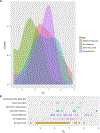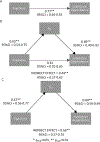Clinical correlates of subsyndromal depression in African American individuals with psychosis: The relationship with positive symptoms and comorbid substance dependence
- PMID: 30482645
- PMCID: PMC6486464
- DOI: 10.1016/j.schres.2018.10.022
Clinical correlates of subsyndromal depression in African American individuals with psychosis: The relationship with positive symptoms and comorbid substance dependence
Abstract
Patients with psychosis exhibit subsyndromal depressive symptoms during the course of illness and yet the clinical correlates of these symptoms remain under-investigated. We aimed to investigate the clinical correlates of subsyndromal depression in psychosis including the extent to which they mediate commonly observed comorbid substance dependence. We developed a model of depression in a non-clinical sample recruited via Amazon's Mechanical Turk (N = 266), and confirmed that model in a locally recruited African-American clinical sample comprising psychotic and non-psychotic individuals (N = 256). Using scores from this model we tested: the strength of relationships between depressive symptomatology and positive, negative and disorganized symptoms in a range of psychotic disorders; whether depressive symptoms were higher in individuals with affective psychoses versus schizophrenia; and if depressive symptomatology mediated the relationship between psychosis and substance dependence. Subsyndromal depressive symptomatology was significantly higher in individuals with psychosis than without psychosis, but did not significantly differ between affective and non-affective psychotic groups. Depressive symptomatology was significantly related to positive (but not negative or disorganized) psychotic symptoms, and mediated the relationship between psychosis and substance dependence. The present study underlines the importance of assessing subsyndromal depression in patients with psychosis, and generates a number of testable predictions for future work. In particular, the examination of the relationships between comorbid psychopathology, namely depression and substance abuse, may improve insight into the neurobiology of psychosis.
Keywords: Crowd sourcing; Depression; Psychosis; Structural equation modeling; Substance Dependence.
Copyright © 2018 Elsevier B.V. All rights reserved.
Conflict of interest statement
Figures




References
-
- Allan R, Martin CR, 2009. Can the Hospital Anxiety and Depression Scale be used in patients with schizophrenia? J.Eval.Clin.Pract 15 (1) 134–141. - PubMed
-
- Amazon, 2015. amazon mechanical turk (beta) Requester Best Practices Guide 2018. (09/24).
-
- Andreasen NC, 1995. Symptoms, signs, and diagnosis of schizophrenia. Lancet 346 (8973) 477–481. - PubMed
-
- Bearden CE, Freimer NB, 2006. Endophenotypes for psychiatric disorders: ready for primetime? Trends Genet 22 (6) 306–313. - PubMed

